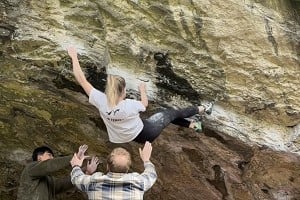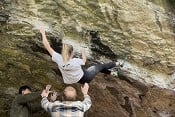
Hi All,
So I'm heading out to Rjukan, Norway in February as part of one of those guided ice climbing weekends. First time I've done winter climbing so I have no idea how to dress properly?
I have all of the clothing for other uses i.e. fleeces, down jackets, waterproof shells, etc - (always open to buying new stuff too!) but just looking for tips on how to specifically wear / layer?
Mine would be
Base layer
Fleece
Windproof
Hardshell
Belay jacket
Then take off kit or add an extra mid layer depending on how quick/ we were moving
Lee
Gloves whilst climbing should be as thin as possible whilst keeping warm. Then also have a much thicker pair of gloves/mitts whilst waiting around/belaying.
It can be worth having a further spare pair of climbing gloves in case your first pair get wet.
Hi Lee,
Really appreciate your help!
I was thinking Baselayer, fleece, down jacket and then a Rab Kinetic Alpine as softshell waterproof? Is this suitable or is it better for the down to be the final layer?
Personally I prefer the soft shell route for layering. A base layer and a soft shell jacket with a synthetic jacket to put on top when you stop at belays etc. (That's why they are called belay jackets) If it's really cold when climbing an additional insulating layer or a thicker base layer can help. Down becomes useless when wet and I would only carry a full waterproof in the UK. If it's so wet that you need a waterproof in Rjukan you will not be going ice climbing
I am more than warm enough when climbing with this system but it is a very personal thing.
Al
I get cold so this might be more than some people recommend: I too leave the hardshell and synthetic belay jacket in my sack 9 days out of 10 when waterfall ice climbing, though the belay jacket may dangle from harness on colder or windy days or on longer routes. My usual is a warm baselayer, a grid type midlayer - mine's a Patagonia R1 - with the hood up it's almost like having a balaclava, and on top a fairly heavy, stretchy, hooded, windproof and water resistant softshell. My legs look after themselves usually with long powerstretch pants under softshell trousers, preferably with braces. Glove management is vital - 3 pairs + Dachsteins for when it gets REALLY cold on stances! Keep a pair warm under your armpits but don't forget they're there when you open your jacket - can get expensive!
A key thing I think is to take enough clothing to be flexible. There is a good chance that day to day the conditions will change quite a bit. I have had some trips where it was -30C one day and just below freezing the next. If I had not taken everything I have I would easily have missed out on good days. Best to be prepared.
One of the good (and obvious things in hindsight) I was told was to think about the temperature. Hard shell and down jacket are pretty much mutually exclusive. If it is wet enough for a hard shell it will likely be too warm to need a down or thick primaloft jacket. If it is cold enough for a down/big primaloft jacket it is unlikely to be wet enough to need a hard shell.
However, I have been out on days where it was cold and safe enough to climb but there was water running on the ice. So a hard shell can definitely come in handy (and is obviously good for wind as well). I only wish I had my hard shell on last January. I climbed a route that had a lot of running water as it was in a sun trap. My normal primaloft was soaked through by the time I topped out. But in the time to rig the abseil and then abseil it had frozen solid.
> If it's so wet that you need a waterproof in Rjukan you will not be going ice climbing
Simply not true, some of the icefalls there have so much waterflow that if you climb in the wrong spot, you'll be completely soaked all the while it is -10 C.
So I waterproof for the actual climbing isn't that far fetched. And same goes by proxy to the synth belay jacket... After all, putting that lovely warm down jacket on top of the wet jacket makes the belay quite soon less desirable and more suffering.
I usually run quite hot so don't want to wear too much and sweat all day. I am looking at the Rab Kinetic Alpine jackets (softshell with hardshell properties). Thinking that baselayer, fleece, a Patagonia puffer vest and then the (waterpoof) softshell would work? With a down jacket as a belay jacket for when I'm stationary?
I think you missed the smiley. It is ONLY my opinion based on MY personal experience, which is extensive I might add, so it's a little unfair to dismiss it as "simply not true". To be fair I could add that, other than under exceptional circumstances, I tended to avoid ice falls that were so obviously full of running water.
Al
I go soft shell have a very warm jacket for belays. 3 or 4 pairs of gloves. Have a pair for climbing only then stuff these inside your fleece. Do not do anything else with these gloves always use the others for belaying and faffing. I have used a pair of very cheep PVC water proof bottoms for the Vormark bridge right hand as this can run with water. A Base Layer fleece with a hood I find is good. A very good place to go you will have a fab time if a little busy
So looking at your list. Get more gloves. (I always have 4 pairs) And make sure a hat goes under your helmet. Enjoy!!!!
> I usually run quite hot so don't want to wear too much and sweat all day. I am looking at the Rab Kinetic Alpine jackets (softshell with hardshell properties). Thinking that baselayer, fleece, a Patagonia puffer vest and then the (waterpoof) softshell would work? With a down jacket as a belay jacket for when I'm stationary?
This sounds sensible to me and pretty much what I go for. I also run quite hot when moving but find that I therefore get very cold when not moving so need a really good down or heavy primaloft for belaying and between climbing.
The other thing to think about is socks. I suffer from cold feet, particularly in rigid ice climbing boots. So make sure you have really good socks (and enough room to wiggle your toes to get them warm).
I am sure you will have a great time and remember (a little) suffering is all part of the fun/experience of ice climbing.
I went to Rjukan for the first time last year. This is what I ended up wearing most of the time:
- Baselayer
- Thin fleece (Polartec Micro)
- Hardshell trousers (medium weight softshell trousers underneath)
- Hardshell jacket
- Big belay jacket for when you're not climbing
- Two pairs of decent gloves are a must as the icefalls do have water running through them, even when they are in good condition. The Black Diamond Glissade worked perfectly for me.
I did have thicker fleeces/light down jacket with me, but didn't need them. If it's a beginner's ice climbing trip (is it a Skyhook Adventure trip by any chance?), you're probably going to go to a single pitch crag like Ozzimosis or Krokan, so it's gonna be quite easy to put on or take off layers as needed.
I'm going back next year and will be dressing the same way again.
I would be a bit suspicious of any categorical advice on this. Sometimes full waterproofs works well, sometime they are totally unnecessary. The rock shape around the ice you are climbing can have a big impact on how wet it is or not. If you are climbing just an open slab of ice, like an easy icefall (perhaps better described as a ice sheet) down an open hillside, even if the ice is really wet itself, beyond your gloves you won't need waterproofs short of it raining on you. But climb ice in a confined space with rock overhangs above you for example, even if the icefall you are climbing is still slabby and easy itself, you may well have water dripping and actually running on to you from above. Complex ice structures are even worse for this. It happens even when the air temperature is well below freezing. If you don't wear shell trousers, you can get soaked thighs from drip hitting your legs when you are bent kneed and your thigh is horizontal. Its a horrible feeling of water soaking through your layers while you can't escape from a position, ie when placing a screw. I don't like climbing with my hood up, but water running off your helmet and down your neck at -10 isn't great either.
I'd be inclined to start with full waterproofs, with baselayer and a thin fleece top and then a belay jacket to go over the top for belaying. I reckon lots of people are either very precious about their down jackets or do something very weird to soak them, because I've found over 25 years of winter ice climbing, they're not nearly as delicate as many presume. Nevertheless the weight penalty for a synthetic jacket isn't too much. Probably just use whatever you already have.
I should also say, I hate you I have decided to cut down and hopefully eliminate all air travel. Now all this talk of ice climbing has got me looking at possible destinations for Jan/Feb. Damn. The irony of going ice climbing contributing to global warming.
I don't know whether you're going cragging or multipitching, but if mostly cragging - some people bring a thermos of hot fruit juice or tea or whatever. This, plus being well-hydrated in general (it's very tempting to avoid drinking the cold water) will make you feel a lot more warmer - the difference of a layer at least.
Even tho it's Rjukan and the approaches are relatively short it's worth planning to have a synthetic baselayer if going for any routes that have a little longer approach. Then change to a merino at the base of the route. On a warm day the trip up to Tjønnstadbergfossen can be a sweaty affair, as can wading through thigh deep powder in the snow in the gorge.
For the most part it probably won't be necessary but as you say you run hot it can be good practice and you'll start your climbs warm and dry.
To reiterate what others have said; gloves gloves gloves. One pair for climbing, one pair for belaying (that stay in your jacket) , a spare pair and some emergency mitts in the sack. Get gloves that allow you to operate carabiners effectively. Thin and tight is great for climbing but make sure your belay gloves are looser.
Remember to prehydrate and rehydrate.
I won't comment on layers you will figure out very quickly what works for you.
Then change to a merino at the base of the route.
I'd rather go bare chested! Merino? Stinky itchy stuff, that is.
> I usually run quite hot so don't want to wear too much and sweat all day. I am looking at the Rab Kinetic Alpine jackets (softshell with hardshell properties). Thinking that baselayer, fleece, a Patagonia puffer vest and then the (waterpoof) softshell would work? With a down jacket as a belay jacket for when I'm stationary?
I’m not sure the Kinetic Alpine will stand up to the rigours of winter. I have one for three season use and will definitely wear something tougher when the tools come out.
Any suggestions for tougher jackets?
> Any suggestions for tougher jackets?
There are loads and I’d advise cruising the websites looking for Napoleon pockets, ie the entry is next to the front zip not beneath the armpits. Very useful if one handed and wearing gloves. These are the shells designed for winter climbing and you can reasonably expect them to be a tougher grade of outer fabric. Then see if you can pick up in the sales in May/June, or secondhand on UKC or in one of the Facebook groups. I sold my lightly scuffed ME Tupilak (a £300 jacket) here a few seasons back for under £100. You’ll still scuff even the toughest shells so not too pricey is sensible as you make first steps.
Gloves must be of good quality. And have a good layer. It might be worth having a spare pair of climbing gloves in case your first pair gets wet. I travel often and myself face such a problem.
I'm off to Cogne for my first ice climbing trip next Feb so interested in different layering opinions as I'm trying to work out what to do.
I've got a proton lt that I was planning on wearing under a thin softshell, but going by some of the posts that might be overkill?
Might be stating the obvious but ensure your gloves are waterproof or at least the outer ones are. I took off my Goretex mitts to climb an icefall in Ryukan (for some reason) and my fingers froze, it was a silly thing to do. I could barely hold my axes by the end of the first pitch.
With gloves I have found the optimum to be;
Wear one (not extra thick) pair for climbing, with a separate inner thermal lining pair.
At a belay, once safe, put said climbing gloves inside the front of your clothing, and change into a pair of well water-proofed (goretex ?) mitts or larger gloves (which I carry clipped to the back of my harness), and use these for the ropework - which is when the wet rope goes through your hands.
When it's your turn to climb, return large gloves to the back of the harness, and change back into your (nice and warm) thinner gloves - which make it much easier to handle carabiners and so forth.
Carry a spare pair of climbing gloves, and a spare pair of thermal lining gloves, either in a pocket, or else in a small rucsac (this sac can be shared, and carried by whoever is seconding - also means food and drink can be carried this way). If funds permit, a spare pair of thicker goretex gloves can be carried here as well.
You can never have too many gloves, always keep your hands dry - that way you have a chance of staying warm.
I went to Rjukan with Rob Johnson's Expedition Guide in Feb this year and on the last day I was climbing in a t-shirt*!
I wore: long johns, Haglofs Rugged Mountain Pants, synthetic t-shirt, mid-layer, soft-shell. Smartwool PHD mountaineering socks (plus sock liners), Lowe Alpine Alpinist and Velocity gloves (with liners). I took extra kit but it wasn't necessary.
I was plenty warm for the entire week but it was warm this year with some routes not having formed and signs of an imminent thaw. Going again in 2020 and preparing for colder conditions!
*Admittedly I was the only person climbing in a t-shirt.
Gloves:
I was well prepared when the temperature was above minus seven but not well equipped on the one day it dropped to minus seventeen.
Anyone recommended puffy pants for all the standing around in yet?
Puffy pants? - is there an origin story for the username ColdWill ?
Elsewhere on the site
Winter Conditions
This Winter Conditions page gives a summary of what is being climbed at the moment, what is 'in' nick and what the prospects are...








